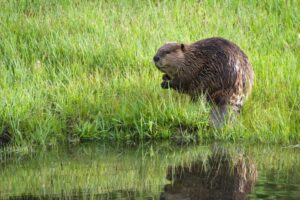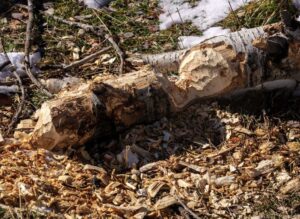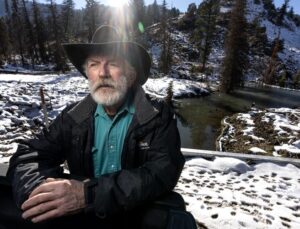I think it’s high time for a little good news from Utah. Don’t you think? This from the Salt Lake Tribune by Jordan Miller.
This Utah animal is helping landowners fight wildfires, climate change and drought
 Jay Wilde has worked on his Preston, Idaho, ranch just north of the Utah border for most of his life. Growing up, one of its biggest pests were beavers.
Jay Wilde has worked on his Preston, Idaho, ranch just north of the Utah border for most of his life. Growing up, one of its biggest pests were beavers.
The pesky rodents muddied up irrigation ditches and blocked culverts, he said, and he wanted them gone. But after moving back in 1995, he experienced a major “paradigm shift.”
With the help of Utah State University’s Beaver Ecology and Relocation Center, he opened his property as a haven for the species in 2015. Now, the area is home to over 200 beaver dams — which have increased the ranch’s creek flows and helped a vulnerable fish species thrive.
“There’s still those folks out there that haven’t accepted the fact that we need them,” Wilde said. “But by and large, the whole attitude of beavers is beginning to change.”
Yes we do Jay. I couldn’t have said it better myself. Except I would add that iin order for US to be healthy we need healthy watersheds which means HUMANS need beavers.
 Utah State’s beaver relocation program re-homes an average of 75 beavers each year, restoring ecosystems where beavers have played a crucial role for thousands of years — all with support from the Utah Division of Wildlife Resources and the U.S. Forest Service.
Utah State’s beaver relocation program re-homes an average of 75 beavers each year, restoring ecosystems where beavers have played a crucial role for thousands of years — all with support from the Utah Division of Wildlife Resources and the U.S. Forest Service.
Nick Bouwes, who serves as the program’s director, has studied the effects of beavers on stream restoration for over 13 years. The USU professor previously used beaver dam analogs — or man-made beaver dams — to restore salmon habitats in Oregon.
These fake dams have been a go-to for stream restoration for about a decade, Nate Norman, the center’s lead field biologist, said. They can be scaled to the size of a water body and help disperse water across floodplains, rehydrating parched areas.
Together, Bouwes and USU professor Joe Wheaton started a company to implement such dams in areas across the West before deciding in 2017 to go a step further — incorporating live beavers to the same sites.
“It started pretty small,” Norman said. “The first year we were able to trap and release five beavers, and the program has grown from there.”
Now, the program has a permanent “beaver bunkhouse” at Utah State with custom-built kennels that “mimic the comforts found in a beaver pond,” according to the center’s website.
Good. Because the university program that reintroduces beavers seems to have the motto of “If she dies, she dies…” I have a modicum of faith that you guys will get this right.
 Each kennel has a concrete “pond” that slopes down into a deep-water area for cover, along with a makeshift lodge in the shallow section. The “lodge” can house several beavers, and each kennel includes a camera and a thermometer to monitor the rodents’ health.
Each kennel has a concrete “pond” that slopes down into a deep-water area for cover, along with a makeshift lodge in the shallow section. The “lodge” can house several beavers, and each kennel includes a camera and a thermometer to monitor the rodents’ health.
These beaver “guests” only check-in after a landowner reports a nuisance beaver to the program. Norman then dispatches to assess the situation.
“This could be anything from a beaver that chewed on one tree one night, or it could be a colony of several beaver dams and lodges on a large ranch,” Norman said.
If Norman determines a beaver is likely settling down in the area, he’ll set out traps to catch the animal.
“They live in families, and so we tried to catch the entire family and relocate them all together,” Norman said. To make sure an entire family has been rounded up, Norman “tests” the area by breaking the beavers’ dam.
“If nobody fixes the dam, that’s usually a good indication that there’s nobody left there, we’ve got them all — because beavers really hate to have their dam broken,” he said.
Back at the bunkhouse, the beavers are quarantined for three days to make sure they don’t transmit any diseases or parasites. Volunteers clean the facility, replace their water each day and feed them one of their favorite meals: wood.
That wood typically comes from branches, which volunteers cut down from willow, cottonwood or aspen trees. Beavers also love root vegetables, Norman said, along with squash or pumpkins.
Once quarantine is over, it’s time for their relocation. First, a few man-made dams are assembled in a designated release area, to help establish a habitat. Then, the beavers are set free “to hopefully survive and thrive and save the ecosystem,” Norman said.
Sure seems like an awful lot of trouble to go to just because some landowners don’t know what’s good for them. But okay. It’s easier to move beavers than change minds. I get it. But I’m still trying.
Emily Fairfax, who serves as an assistant professor with USU’s Department of Watershed Sciences, also works as an assistant professor at California State University Channel Islands, where she leads a research group called BEAVS- which studies beavers, ecohydrology, and visual storytelling.
In Utah, Fairfax has seen evidence of beavers in some of the state’s most barren landscapes, including beaver-chewed sticks floating down the Green River, or canals beavers have dug near Desolation Canyon.
“They’re already engineering incredibly harsh environments,” Fairfax said. “So I’m optimistic that they will continue to be our climate ally, even if things get a little bit worse in the future.”
In dry climates like Utah, beavers play a crucial role in slowing water down, so precipitation has time to seep into the landscape, she said.
They also help slow down water in snowmelt-driven systems, where water can run out by June or July if it just comes “screaming through” degraded water channels.
“They’re like speed bumps for that water,” Fairfax said of beaver ponds. “And when the water is slowed down, and it gets stored, then the vegetation can keep accessing the other roots — even into July, August, September, October.”
“And that lets the vegetation stay green and lush,” she continued, “so it never really reaches that super dry, crispy fuel state that makes wildfires so intense.”
Slowing down snowmelt and giving water time to seep into the ground also helps with aquifer recharge — which Utah’s groundwater sources have been lacking.
This recharge depends on an area’s geology, Fairfax said, but research has shown that once beavers occupy a stream, there is a local rise in the water table. And if the species persists over time in that area, there can be “true aquifer recharge” — which can affect areas far beyond a beaver pond.
Okay, we’re taking these beavers to somewhere they want not to burn up and their wells not to dry. I understand that’s not what YOU personally want. TTFN. We’ll be on our way. Good luck being thirsty and flammable.
These beaver ponds double as carbon sinks, too, because the wetlands they create can help remove carbon dioxide from of the atmosphere and even slow global warming.
“In terms of adaptation, or dealing with the effects of climate change — when a riverscape is unhealthy, when it’s degraded and it’s been overly modified by people, it cannot resist any disturbances,” Fairfax said. “A drought, a flood, a fire — any of those that come through is just going to make that system even more unhealthy.”
But when beavers are in an area, they can nudge a riverscape back toward restoration, she said.
“Then when you have a disturbance… the river just handles it like it’s meant to do,” she said, “because it’s been part of this planet for millions and millions and millions of years, and it should be able to persist through natural disturbances.”
Beavers get over it. They help YOU get over it. It’s what they do.
 Wilde has seen the talents of beavers firsthand. The Beaver Relocation Center established a few man-made dams on the Idaho rancher’s property before relocating five beavers there in 2015, and Wilde credits those dams to enticing the animals to stay in the area.
Wilde has seen the talents of beavers firsthand. The Beaver Relocation Center established a few man-made dams on the Idaho rancher’s property before relocating five beavers there in 2015, and Wilde credits those dams to enticing the animals to stay in the area.
That’s because beavers need deep water, Wilde said — their entire defense mechanism when evading predators relies on hiding in it.
“So we just added some security to them long enough so they could get their own dams and complexes put together,” he said, “and away they went.”
Wilde’s ranch is located along Birch Creek, which is a tributary of the Bear River. The creek dries up each year, and ever since he moved back in the 1990s, he’s noted the exact date that the water has disappeared annually.
That’s why he knows that since the beavers made a home at his ranch, the creek has seen between 40-50 additional days of water flow.
This year, the creek has continued to flow for 75 more days, Wilde said.
“They’re pretty reclusive, and you don’t see a lot of them,” Wilde said. “But usually, along toward dusk in the evenings, they’ll come out and be swimming around, and working on those on those dams.”
The beavers’ work has allowed other wildlife in the area to thrive, he said. In 2001 and 2012, for instance, the Forest Service recorded fewer than five Bonneville cutthroat trout per 100 meters on Birch Creek.
But in 2019, after the beavers were established, the Forest Service recorded about 70 of the threatened fish per 100 meters.
“My whole goal was to try to get the stream to flow,” Wilde said. “But you know, the effect that it’s had on those fish? That’s just been phenomenal.”
Wilde’s ranch has received nine relocated beavers over the years — all for free. Interested landowners can get involved by contacting their local DWR office, or the ecology center directly.
“They are the most calm animal. They are chill,“ Norman said. “They’re an amazing little rodent.”
How true. What a FANTASTIC article Jordan Miller has written. Spoken like a true believer who actually did her homework. There’s a reason why Utah is neck and neck with Washington for being the smartest beaver state. I am always happy to be reminded of why.







































2 comments on “BEAVERS: A PHENOMENAL IMPACT”
Bob Conley
November 4, 2022 at 12:25 pmEnjoyed all the beaver news.
heidi08
November 4, 2022 at 12:59 pmThanks Bob! Come back because there’s always more where that came from!